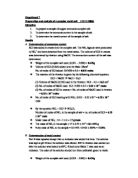Experimental Procedure
Preparation of 0.01 M EDTA Solid disodium ethylenediaminetetraacetate dehydrate (EDTA) was obtained from the lab instructor, and 3.6900 ± 0.00001 g of the solid was weighed by analytical balance and quantitatively transferred into a 250-mL beaker. Using deionized water, the mass of solid was then quantitatively transferred to a 1-L plastic bottle to prevent EDTA from leaching, and the bottle was filled with 1000-mL of DI water and mixed and shaken thoroughly to completely dissolve the salt in water.
Preparation of Standard Zinc Solution Using the analytical balance, exactly 0.5012 ± 0.00001 g of high purity zinc metal was weighed in a 150-mL beaker. Then, 10-mL of 6M HCl was added slowly to the zinc in the hood while carefully keeping the beaker covered with a watch glass to prevent zinc from escaping during the vigorous reaction with HCl. After the vigorous initial reaction slowed, the solution was heated in a steam bath at 75 degrees-Celsius to completely dissolve the species for one hour. After the dissolution, the zinc was quantitatively transferred to a 500-mL volumetric flask. The flask was filled to the line with DI water and upended 15 times to ensure the solution was complexly dissolved.
Standardization of EDTA solution. Three aliquots of standard zinc solution were prepared by carefully pipetting 10.0±0.2 mL into three 250-mL Erlenmeyer flasks using a volumetric pipette. Dilute (0.0993M) NaOH solution was added to the flask dropwise to raise the pH until a faint white color was observed. Then, 10 mL of 8.5M NH3/NH4Cl buffer, two drops of eriochrome black T indicator, and 50mL of deionized water were added to zinc solution, and the aliquot was ready for titration. A 50-mL buret was filled with the EDTA solution, and the zinc solution was titrated dropwise while swirling the flask until the color changed from purple to a pure rich blue color, which signified the endpoint. The color change was extremely sharp and was observed within a fraction of a drop. This procedure was repeated two more times with the remaining two aliquots.
Results
Table 1 describes the mass measurements for preparing the standard zinc and EDTA solutions. Table 2 includes results for each titration of the three aliquots. Table 3 holds the molarity of EDTA and zinc determined by the experiment.
Sample Calculations
Amount EDTA added plus error propagation:
Amt EDTA = End volume – Start Volume = 30.39-15.19mL = 15.20 ± 0.014mL
Error:
M Standard Zinc Solution:
M = (wt. Zinc metal / atomic wt Zinc)(0.500mL)-1 = (0.5012g / 65.39g∙mol-1) (0.500mL) = 0.01533(1) MZn
SR=0.00001g
M EDTA solution plus error propagation:
M = (M Zn x Volume Zn used) / Volume of EDTA added = (0.01533M x 0.010L) / 0.01519 L
= 0.010090(23) M Standardized EDTA solution for Run (1).
Error:
Sample Calculations
Average Molarity of EDTA (μ): (0.010090 + 0.010086 + 0.010066) / 3 ⇒ μ = 0.010081 M EDTA
Standard Deviation: = ⇒ s = 0.000011 M EDTA
Relative Standard Deviation (RSD): (s/μ) x 1000 = (0.000011/0.010081) x 1000 ⇒RSD =1.04 ppt ⇒ 0.104% error
Discussion
The molarity of standardized zinc solution was calculated to be 0.01533(1) M, and the average standard molarity of EDTA solution was experimentally determined to be μ = 0.010081 M EDTA, and the standard deviation was s = 0.000011 M EDTA. In terms of precision, the relative standard deviation for the experiment was 1.04 ppt, which implies that the measurements were all “quantitative and precise,” according to Christie Enke since the value is within 10ppt.1 Since there was no true value established for this lab, this experimental value could not be evaluated for accuracy. This experiment was carried out very carefully and achieved strikingly precise results for the standardization of EDTA solution.
Sources of error that could lead to imprecision or inaccuracy in this experiment come from determinate and indeterminate sources. If insufficient ammonium was added to the solution, this could have led to the solution not being alkaline enough and the proper proton exchange with black T indicator would not be achieved at the proper pH, and this could be solved easily by checking the pH to make sure it is basic enough. Other errors are inherent in the analytical balance because it can only measure out to its last significant digit. Also, errors could have occurred by using contaminated or dirty glassware, or leaving residual solid from the weigh boats and glassware after transferring the quantities. Simply making sure to use clean glassware can minimize the first, and the second can be solved by quantitatively transferring the analytes between containers and thoroughly washing the weigh boat or beaker with the solution it is entering. Another error in measurements could occur by human error in not estimating the volume on the buret accurately, which is inherent to the titration in this experiment. The best way to minimize human error is to be consistent with the estimations between hash marks on the glass buret.
Conclusion
The goals for this experiment were achieved by preparing solutions of zinc and EDTA, calculating the molarity of standardized zinc solution (0.01533(1) M), experimentally determining the standard molarity of EDTA solution (μ = 0.010081 M EDTA) by titration, and calculating its standard deviation (s = 0.000011 M EDTA). In terms of precision, the relative standard deviation for the experiment was 1.04 ppt, which implies that the measurements were all quantitative, or precise.
Literature Cited
-
Enke, Christie G.; The Art and Science of Chemical Analysis; John Wiley and Sons: 2001 p. 40.








